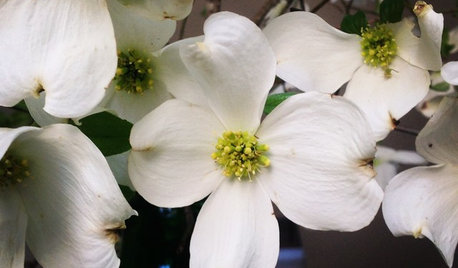Help! White fungus on dogwood tree...
Linda Ross
14 years ago
Related Stories

WINTER GARDENINGHow to Help Your Trees Weather a Storm
Seeing trees safely through winter storms means choosing the right species, siting them carefully and paying attention during the tempests
Full Story
GARDENING GUIDESTree Care: Common Tree Diseases and What to Do About Them
Learn to recognize trees that may be affected by diseases or pests so you can quickly take action
Full Story
LANDSCAPE DESIGNHow to Help Your Home Fit Into the Landscape
Use color, texture and shape to create a smooth transition from home to garden
Full Story
GARDENING GUIDESGreat Design Plant: Cornus Florida Benefits Wildlife
Flowering dogwood provides fiery red foliage in fall and beautiful springtime blooms
Full Story
SPRING GARDENING7 Spectacular and Practical Spring-Flowering Trees
Put on a beauteous show in the garden with a landscape tree awash in flowers — just do your homework first
Full Story
GARDENING GUIDESPrunus Virginiana Thrives Under Deciduous Trees
Plant chokecherry for showy white flowers favored by native bees in spring, and to provide nesting habitat and food for birds
Full Story
GARDENING GUIDESGreat Design Plant: Amelanchier Signals Spring With Airy White Blooms
With roughly 20 species of serviceberry native to the U.S., bees can feed on the early-season blooms while birds enjoy the summer berries
Full Story
ARBOR DAY8 Reasons to Plant a Great Tree
Beauty is its own reward, but the benefits of planting the right tree in the right place go way beyond looks
Full Story
LANDSCAPE DESIGNThe Unparalleled Power of Trees
Discover the beauty and magic of trees, and why a landscape without them just isn't the same
Full Story
EDIBLE GARDENSHow to Add an Apple Tree to Your Edible Garden
Readily available, beautiful and fragrant, apple trees offer four-season interest along with crisp, juicy fruit
Full Story





reaverg
idig
Related Professionals
Sahuarita Landscape Architects & Landscape Designers · Cupertino Landscape Contractors · El Sobrante Landscape Contractors · Ellicott City Landscape Contractors · Golden Gate Landscape Contractors · Maywood Landscape Contractors · Pikesville Landscape Contractors · Pleasant Hill Landscape Contractors · Waipahu Landscape Contractors · Wallingford Landscape Contractors · Augusta Siding & Exteriors · Largo Siding & Exteriors · Milwaukee Siding & Exteriors · Thornton Siding & Exteriors · Wilmington Siding & ExteriorsLinda RossOriginal Author
rhizo_1 (North AL) zone 7
Linda RossOriginal Author
idig
rhizo_1 (North AL) zone 7
Linda RossOriginal Author
rhizo_1 (North AL) zone 7
scandia
rhizo_1 (North AL) zone 7
idig
reaverg
rhizo_1 (North AL) zone 7
reaverg
Tlparson_yahoo_com
catbird